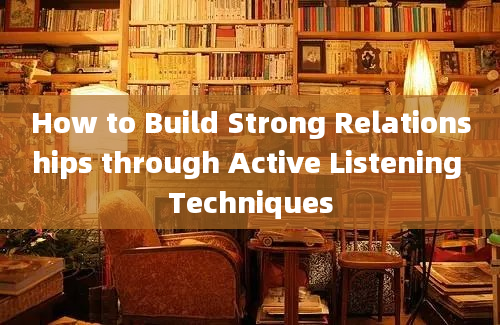How to Build Strong Relationships through Active Listening Techniques

Building strong relationships is essential in both personal and professional contexts. One of the most effective ways to foster these relationships is through active listening. Active listening is not just about hearing words; it involves understanding the message, showing empathy, and responding thoughtfully. This article delves into the techniques of active listening and how they can be used to build robust and meaningful relationships.
What is Active Listening?
Active listening is a communication skill that involves fully concentrating, understanding, responding, and then remembering what is being said. According to the University of Colorado Boulder, active listening is a key component of effective communication and can significantly enhance interpersonal relationships ([source](https://www.colorado.edu/communication/2018/01/29/activelistening)).
Techniques of Active Listening
1. Pay Full Attention: Avoid distractions and focus entirely on the speaker. This shows respect and interest.
2. Show That You Are Listening: Use body language like nodding, maintaining eye contact, and leaning slightly forward.
3. Reflect and Clarify: Paraphrase what the speaker has said to ensure understanding. For example, "So, what you're saying is..."
4. Ask Questions: Pose openended questions to encourage the speaker to elaborate.
5. Avoid Interrupting: Let the speaker finish their thoughts without interruption.
6. Empathize: Try to understand the speaker's feelings and perspective.
7. Respond Appropriately: Give feedback that is honest and respectful.
Benefits of Active Listening
Active listening has numerous benefits, including:
Improved Understanding: Helps in comprehending the speaker's message accurately.
Enhanced Trust: Builds trust as the speaker feels heard and valued.
Conflict Resolution: Aids in resolving conflicts by ensuring all parties feel understood.
Stronger Bonds: Fosters deeper connections and stronger relationships.
RealWorld Applications
In the workplace, active listening can improve team collaboration and leadership effectiveness. A study by the Harvard Business Review found that leaders who practice active listening are more likely to have engaged and productive teams ([source](https://hbr.org/2016/07/whatgreatlistenersactuallydo)).
In personal relationships, active listening can enhance emotional intimacy and reduce misunderstandings. The Gottman Institute emphasizes the importance of active listening in maintaining healthy marriages and relationships ([source](https://www.gottman.com/blog/activelistening/)).
Conclusion
Active listening is a powerful tool for building strong relationships. By practicing these techniques, individuals can improve their communication skills, foster trust, and create more meaningful connections. Whether in personal or professional settings, the benefits of active listening are profound and farreaching.
Frequently Asked Questions (FAQs)
1. What is active listening?
Answer: Active listening is a communication skill that involves fully concentrating, understanding, responding, and remembering what is being said. It goes beyond just hearing words and includes showing empathy and providing thoughtful responses.
2. Why is active listening important in relationships?
Answer: Active listening is crucial in relationships as it builds trust, enhances understanding, aids in conflict resolution, and fosters deeper connections. It makes the other person feel valued and heard.
3. How can I show that I am actively listening?
Answer: You can show active listening by maintaining eye contact, nodding, leaning slightly forward, and using verbal affirmations like "I see" or "I understand."
4. What are some common barriers to active listening?
Answer: Common barriers include distractions, preconceived notions, interrupting the speaker, and lack of interest. Overcoming these barriers requires conscious effort and practice.
5. How does active listening help in conflict resolution?
Answer: Active listening helps in conflict resolution by ensuring all parties feel understood, reducing misunderstandings, and fostering a collaborative environment where solutions can be found.
6. Can active listening be learned?
Answer: Yes, active listening can be learned and improved with practice. Techniques like paying full attention, reflecting, and asking questions can be developed over time.
7. How does active listening benefit the workplace?
Answer: In the workplace, active listening improves team collaboration, enhances leadership effectiveness, and leads to more engaged and productive employees.
8. What role does empathy play in active listening?
Answer: Empathy is essential in active listening as it involves understanding and sharing the feelings of the speaker. It helps in building trust and deeper connections.
9. How can I practice active listening in everyday conversations?
Answer: You can practice active listening by focusing on the speaker, avoiding distractions, paraphrasing what is said, and asking clarifying questions.
10. Are there any tools or resources to help improve active listening skills?
Answer: Yes, there are various resources like workshops, books, and online courses that can help improve active listening skills. Additionally, practicing with a partner or mentor can provide valuable feedback.
By incorporating these techniques and understanding the FAQs, you can significantly enhance your ability to build strong relationships through active listening.










